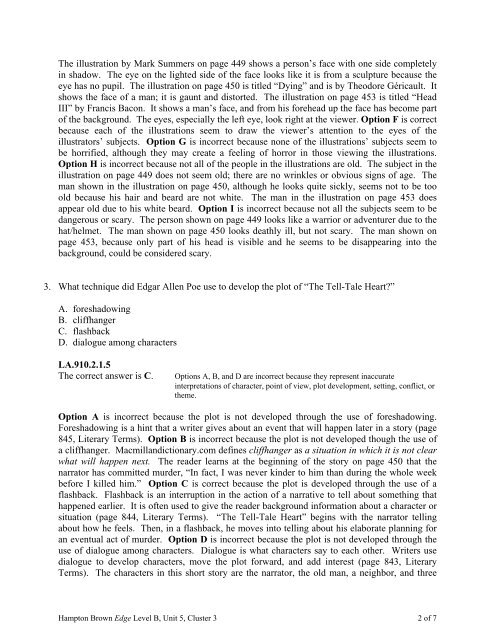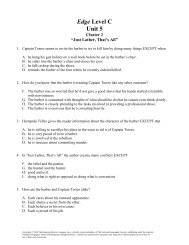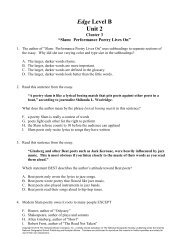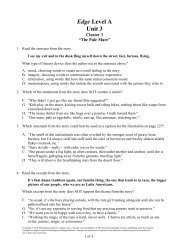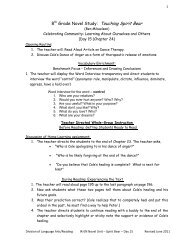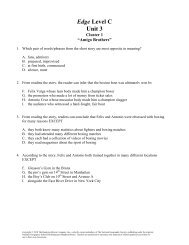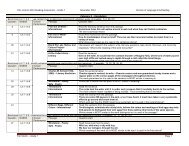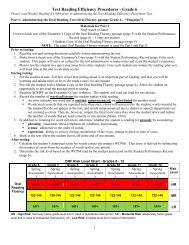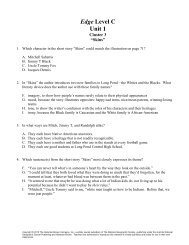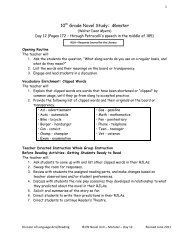Edge Level B Unit 5 - Division of Language Arts/Reading
Edge Level B Unit 5 - Division of Language Arts/Reading
Edge Level B Unit 5 - Division of Language Arts/Reading
You also want an ePaper? Increase the reach of your titles
YUMPU automatically turns print PDFs into web optimized ePapers that Google loves.
The illustration by Mark Summers on page 449 shows a person’s face with one side completely<br />
in shadow. The eye on the lighted side <strong>of</strong> the face looks like it is from a sculpture because the<br />
eye has no pupil. The illustration on page 450 is titled “Dying” and is by Theodore Géricault. It<br />
shows the face <strong>of</strong> a man; it is gaunt and distorted. The illustration on page 453 is titled “Head<br />
III” by Francis Bacon. It shows a man’s face, and from his forehead up the face has become part<br />
<strong>of</strong> the background. The eyes, especially the left eye, look right at the viewer. Option F is correct<br />
because each <strong>of</strong> the illustrations seem to draw the viewer’s attention to the eyes <strong>of</strong> the<br />
illustrators’ subjects. Option G is incorrect because none <strong>of</strong> the illustrations’ subjects seem to<br />
be horrified, although they may create a feeling <strong>of</strong> horror in those viewing the illustrations.<br />
Option H is incorrect because not all <strong>of</strong> the people in the illustrations are old. The subject in the<br />
illustration on page 449 does not seem old; there are no wrinkles or obvious signs <strong>of</strong> age. The<br />
man shown in the illustration on page 450, although he looks quite sickly, seems not to be too<br />
old because his hair and beard are not white. The man in the illustration on page 453 does<br />
appear old due to his white beard. Option I is incorrect because not all the subjects seem to be<br />
dangerous or scary. The person shown on page 449 looks like a warrior or adventurer due to the<br />
hat/helmet. The man shown on page 450 looks deathly ill, but not scary. The man shown on<br />
page 453, because only part <strong>of</strong> his head is visible and he seems to be disappearing into the<br />
background, could be considered scary.<br />
3. What technique did Edgar Allen Poe use to develop the plot <strong>of</strong> “The Tell-Tale Heart?”<br />
A. foreshadowing<br />
B. cliffhanger<br />
C. flashback<br />
D. dialogue among characters<br />
LA.910.2.1.5<br />
The correct answer is C.<br />
Options A, B, and D are incorrect because they represent inaccurate<br />
interpretations <strong>of</strong> character, point <strong>of</strong> view, plot development, setting, conflict, or<br />
theme.<br />
Option A is incorrect because the plot is not developed through the use <strong>of</strong> foreshadowing.<br />
Foreshadowing is a hint that a writer gives about an event that will happen later in a story (page<br />
845, Literary Terms). Option B is incorrect because the plot is not developed though the use <strong>of</strong><br />
a cliffhanger. Macmillandictionary.com defines cliffhanger as a situation in which it is not clear<br />
what will happen next. The reader learns at the beginning <strong>of</strong> the story on page 450 that the<br />
narrator has committed murder, “In fact, I was never kinder to him than during the whole week<br />
before I killed him.” Option C is correct because the plot is developed through the use <strong>of</strong> a<br />
flashback. Flashback is an interruption in the action <strong>of</strong> a narrative to tell about something that<br />
happened earlier. It is <strong>of</strong>ten used to give the reader background information about a character or<br />
situation (page 844, Literary Terms). “The Tell-Tale Heart” begins with the narrator telling<br />
about how he feels. Then, in a flashback, he moves into telling about his elaborate planning for<br />
an eventual act <strong>of</strong> murder. Option D is incorrect because the plot is not developed through the<br />
use <strong>of</strong> dialogue among characters. Dialogue is what characters say to each other. Writers use<br />
dialogue to develop characters, move the plot forward, and add interest (page 843, Literary<br />
Terms). The characters in this short story are the narrator, the old man, a neighbor, and three<br />
Hampton Brown <strong>Edge</strong> <strong>Level</strong> B, <strong>Unit</strong> 5, Cluster 3 2 <strong>of</strong> 7


